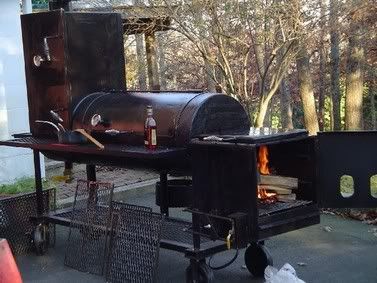Pinball Wizard: Paul Kirk's Pitmaster Secrets
The current issue of Food and Wine magazine has an article from the legendary KC Baron of Barbecue, Paul Kirk. Paul dishes up some recipes and tips on how to make the lip-smackin' cue we all love so much. Having organized one of Paul's pitmaster classes, I can tell you that this man knows his barbecue inside and out, and his claim of being able to read, analyze and improve a recipe without tasting it, is true. He knows more about bbq than just about anyone you'll ever meet. And his restaurant is fantastic.
Thanks to my friend, Andrew Fischel, of RUB BBQ for the heads up on the article.
For the recipes that accompany the article, click HERE or see the links to each at the bottom of the article.
Cook Like a Pit Master
Paul Kirk, the baron of BBQ, gives the lowdown on brisket, chicken and his famous burnt ends.
By Paul Kirk
Some people insist on a lot of fancy equipment to make great barbecue, but they’re wrong. I should know: Since I entered my first barbecue contest in 1981, I have won more awards than I can count (maybe more than 400 of them), and when I compete, I use an $18,000 custom-designed cooker. But to make competition-worthy barbecue at home, you need only a basic kettle grill, a chimney starter and a cooking thermometer.
When I started competing, I didn’t want to share my secrets. At 2 a.m., I’d be at my pit with a penlight in my mouth to hide my work. But other competitors would wake up to watch. Now I conduct master classes, and I don’t win as many contests because my students beat me. I continue to compete because I love great barbecue: slow-cooked, tender, moist and packed with intense flavors. One student, Andrew Fischel, convinced me to help him open RUB (Righteous Urban Barbecue) in New York City in 2005. This summer we’ll open a second branch of RUB in the Rio casino in Las Vegas. We’re not the only ones who love great barbecue.
Whether you’re a pro or a beginner, the technique is the same: low and slow. Compared to grilling, which means cooking quickly over high heat (400° to 450°), barbecuing takes four times as long and almost half the heat (anything below 250°).
Choose your fuel wisely. If you are new to barbecuing, use plain charcoal briquettes, because they burn more consistently and evenly than hardwood lump charcoal, which comes in many different sizes. I start the fire with 50 briquettes—and I am so fussy as to actually count them. Light them in the chimney starter, not with kerosene, or else your meat will taste only of fuel.
The cardinal rule of barbecue: Don’t peek into the cooker unless you have to. Open the lid only to turn the meat, baste it or add more fuel.
Paul Kirk is the author of Paul Kirk’s Championship Barbecue and headmaster of his traveling School of Pitmasters.
RUB, 208 W. 23rd St., New York City; 212-524-4300.
Paul included 4 tips for great bbq, which are located HERE
Recipes: Brisket and Burnt Ends; BBQ Chicken; K.C. Style Sauce; Grandma Kirk's Baked Beans









0 Comments:
Post a Comment
<< Home